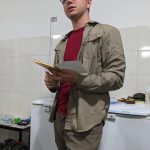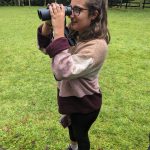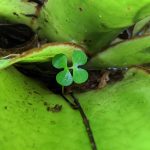Our Friday began with more light rain, overcast skies, and a surprisingly cool 18 degrees C. This was expected, as precipitation in the Mata Atlantica peaks in January, with an average of 14 rainy days in February and a cumulative annual precipitation of 2200 mm. The constant rain and high humidity have prevented our laundry from ever drying and has made our research projects and outdoor activities quite soggy.
Most students used the morning to put the finishing touches on their research projects. My group in particular collected some auxiliary data for our bromeliad tank water quality study. During our data collection, we noticed that the bromeliads in the forest with well developed reproductive organs typically had less water in their tanks, and that bromeliads on the road were typically smaller and had less consistent water quality than the forest specimens. We speculated that this species of bromeliad is best suited to a low disturbance environment with high canopy coverage, and that the tank water acts as a store of nutrients for reproduction. To examine the latter hypothesis, we took photos of each of our sampled bromeliads to categorize their stage of reproductive development. We finished the final touches on our research projects by noon, and some of us went to the north side of the field station to birdwatch, spotting some azure-winged tanagers, saffron finches, and the ever-present parakeets.
The main activity of our afternoon was a trip down to Ubatuba, with the aim of experiencing a Brazilian town and buying souvenirs. Located 20 km down the mountain and 900 m below the field station of Nucleo Santa Viriginia, Ubatuba is a tourist town with a population of around 90 000. The name of the town comes from Tupi for many arrows/canoe. It is known for its beaches, of which there are over 100 in the municipality, and surfing. The town is the official surfing capital of Sao Paulo, and Praia Itamambuca, on the north end of the municipality, is particularly well known for hosting national competitions.
As our visit came on the aftermath of Carnaval, the town felt subdued and quiet. We explored the town for two and a half hours, buying local delicacies such as juçara açai sorbet, Brazilian coffee, empanadas, and Carnaval beer, and souvenirs such as local ceramics, bird books and coffee drips. At 5:30, we took shelter from a sudden onset of rain at the Sullivan Bar Cervejaria, near Projeto Tamar and the Aquário de Ubatuba, and finally bused back up, arriving at the field station at 7:15. Our day ended with barbequing queijo coalho cheese and handmade hamburgers, complete with lettuce, tomatoes, caramelized onions and condiments, and species accounts from Kristen and Hayden, who covered the Red Breasted Toucan and Coral Snake respectively. Kristen taught us that Red Breasted Toucans, similar to flycatchers and owls, are secondary cavity nesters (meaning they inhabit tree cavities made by other species), while Hayden informed us that the ‘red touch black, safe for Jack’ saying is only true for Texas.





Leave a Reply